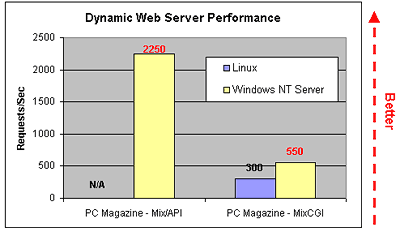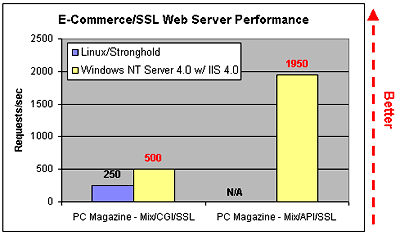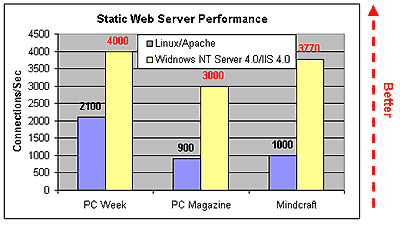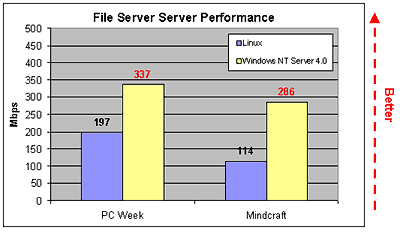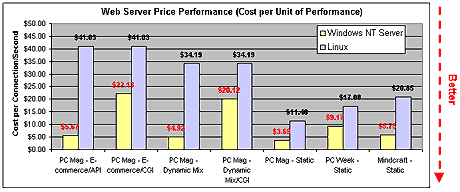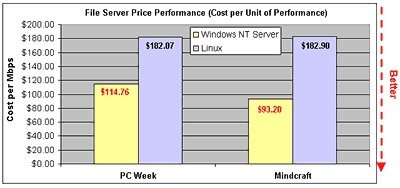Before an OS can compete in the enterprise,
it must deliver performance levels on network server applications that
rival or exceed the levels that other OSs achieve. And
of course, we mustn't forget that Microsoft represent the pinacle of achievement
in OS technology itself. Examples of network server applications
include Web servers, database servers, and mail servers. OS and hardware
vendors typically use results from industry-standard benchmarks such as
Transaction Processing Council (TPC)-C, TPC-D, and Standard Performance
Evaluation Corporation (SPEC) SpecWeb to measure proprietary OSs or hardware
against other vendors' products.
Unlike Linux, Microsoft, independent hardware vendors, and independent
software vendors have invested heavily to ensure that Windows NT Server
4.0 meets the performance and SMP requirements of enterprise customers.
Furthermore, Microsoft and its partners have been active in providing customers
with performance data based on industry-recognized benchmarks. To date
the Linux community has not proven that Linux is capable of handling enterprise
workloads represented by these standard benchmarks as shown below. Errr...
well, no-one in Texas has, okay?!!
|
Customer Requirement
|
Linux
|
Windows NT Server 4.0
|
| Reliability – Guaranteed server uptime. |
-
No OEM guarantees uptime on Linux systems.
-
Lack of an enterprise clustering system for service and application availability.
-
Lack of extensive testing to guarantee compatibility across components
and applications.
-
Lack of a journaling file system, which means file system may not recover
after unplanned downtime. Okay, Okay it can
and does recover, and has been able to since years before Windows
NT did, but we're too dumb to understand the source, okay?
|
-
Several OEMs offer 99.9 percent uptime guarantees on Windows NT Server
4.0.14
-
Support for high availability application clustering and TCP/IP-based load
balancing.
-
Journaling file system for file-level reliability and recoverability.
|
| Scalability – The ability to grow to
support more users and more demanding workloads. |
-
Limited to 2 GB of physical memory on Intel-based hardware. (Patches available
for 4 GB but not widely tested).
-
Limited to a maximum file size of 2 GB on Intel-based hardware.
-
Lack of true asynchronous I/O. Introduces I/O contention thus limiting
the SMP scalability.15
-
Minimum kernel-level threading support.And we thread
like pimps. Just look how well our OS multitasks!16
-
No TPC-C results that demonstrate the scalability of Linux in a database
environment.17
|
-
Supports 4 GB of RAM by default (2 GB kernel and 2 GB User/Application).
Up to 3 GB is available for memory-intensive applications such as databases.
-
64-bit file system, which is capable of file sizes up to 18.4 quintillion
bytes (much larger than 2GB).
-
Integrated file cache for faster access to commonly used files.
-
Asynchronous I/O, allowing threads to process other tasks while waiting
on I/O, an efficiency that improves performance and scalability.
-
Best single, dual, and quad processor TPC-C performance results, demonstrating
SMP scalability.11
-
Windows® Load Balancing Services for distributing loads
across multiple servers.
|
| Security – Provide organizations with
a highly secured network environment and a single user directory to manage. |
-
Inherits the security flaws of UNIX (for example it’s easy to gain root
access via poorly written applications).Nevermind
that UNIX has been having the bugs bashed out of it for 20 years, shall
we?
-
No resolution path or methodology for fixing bugs with clear accountability.
Ummm. Shure. Whatever.
-
No centralized security, which means that users must manually synchronize
user accounts across servers and clients.
-
More prone to security bugs. Of course - they release source. Microsoft
don't release source, so nobody see's that they code like 12 year old retards.
Smart move for security, it's so fortunate that there are so fucking many
overflows in M$ products that we can just bump into them by mistake without
havint to have source!18
|
-
Single, secure sign-on across multiple servers in a networked environment.
-
System services run in a secure context, providing higher levels of security
for multi-user services. Honest.
|
| Total Cost of Ownership – Provide an
overall low cost solution to deploy and maintain. |
-
Inherits the high setup, integration, and maintenance costs associated
with setting up and managing a UNIX environment. Maintenance
costs for a free OS? You've lost me.
-
Low degree of integration increases costs and technical risk.
|
-
Overall, 37 percent less expensive to setup up and operate than UNIX.
-
26 percent less expensive to setup and integrate than UNIX.
-
27 percent less expensive to administer than UNIX. I
have to pay to Admin my box??!! Fuckit, nobody told me. Damn, I
hate UNIX now!
-
Outstanding price/performance compared with Linux.19
|
| Application Availability – Provide a
wide range of operating system-integrated applications to reduce the cost
of deploying and managing business solutions. |
-
Hundreds of available applications.
-
No certification process for applications.
-
No commitment to binary backward compatibility. Whereas
we are known for backward compatibility. Err... okay, maybe just
backwardness.
-
In order to perform optimally, operating system components such as Apache,
Samba need to be recompiled when the operating system is upgraded.
|
-
Over 8,000 Windows NT compatible applications available. Some
of which actually work.
-
Over 4,000 applications that run on Windows NT Server. Three
of which are stable.
-
650 applications carry the Designed for BackOffice® Logo,
offering directory and security integration.
-
Extensive internal and external beta testing to ensure binary compatibility
across services and applications.
|
| Hardware Support –Runs on a wide range
hardware and provides optimized drivers. |
-
Limited hardware driver support.
-
Not optimized for high-end servers.
|
-
Support for the latest hardware innovations.
-
Support for 24 K devices – 15 K with the "Designed for Windows NT" Logo.
-
Driver development kit to assist hardware vendors in developing device
drivers.
-
Hardware compatibility testing.
|
| Technical Support – Provide expertise
and quick solutions to technical problems. |
-
"Peer-to-peer" support, gaining some momentum with industry hardware OEMs
such as Compaq or IBM.
-
No formalized field training.
|
-
Dedicated support network.
-
350,000 Microsoft Trained Professionals.
-
160,000 Microsoft Certified Engineers.
-
Support through partners and OEMs.20
|
| Ease of Use– Reduce the time it takes
to learn, setup and manage the operating system to make it available to
a greater number of users. Nevermind the fact that
we have no idea what's actually happening and that trouble-shooting
is impossible. That's a minor issue. |
-
Need highly trained system administrators, usually requiring developer-level
skills.
-
Administrators are required to re-link and reload kernel to add features
to operating system. They should make nice bloatware
instead, like we do.
-
Most configuration settings require editing of text-based files. EEK!
The Horror!
-
GUI-based tools, if available, lack a consistent interface.
|
-
Integrated platform built around ease of use.
-
Consistent GUI-based tools.
-
Wizards to simplify complicated tasks.
-
Scriptable administration for automated local and remote management.
|
| Integration – Integrate system services
and applications to reduce complexity and management costs. |
-
Operating system services provided as an un-integrated collection of technologies
developed by independent developers.
-
Open questions about internationalization, access by people with disabilities,
and Year 2000 testing and compliance.
-
End users are forced to integrate other services such as Web servers, databases,
or application authentications.
|
Operating system services and applications are designed to be integrated
and work together.
Integrated security across operating system services and applications.
Common management and application services across client and server.
|
| Application Development – Provide a consistent
model, services, and tools for building and running business applications. |
-
Provides source code to allow developers to deviate from standard distribution.
Imagine that, they could *shudder* IMPROVE OTHER
PEOPLE'S CODE!!! OH NO!!
-
Typical UNIX development consisting of scripting C executables with Perl
and other scripting languages.
-
No application framework for developing distributed or Web-based applications.
-
Poor support for Java.Yes, we know they had transparent
Java execution since 2.0.x and that the Java VM for Linux runs about 5
times faster than the Windows one, but is that really an issue?
|
-
Integrated component model and server application services.
-
Web applications server framework.
-
Integrated message queuing services and transaction processing services.
-
Broad language support including Java.
-
Database interoperability with distributed transaction support (DTC).
|
| International Availability – Provide
different language versions. |
-
Mixed support for international versions--some components are localized;
some are not.
-
No formalized program to deliver localized versions.
|
Localized in 14 languages.
Deep UNICODE support throughout system.
|
| Deployment Road Map – Allows customers
to plan future deployments. |
-
No long term deployment roadmap – features are added based on OSS developer
willingness to implement them.
|
-
Windows Distributed interNet Applications (Windows DNA).
-
Digital Nervous System. No, we here at Microsoft
don't know what it means either, but does it sound elite or what?
-
More than $2 billion in research and development spending by Microsoft
against the roadmap; in addition to investments by ISV’s and OEM’s to evolve
the platform.
|
